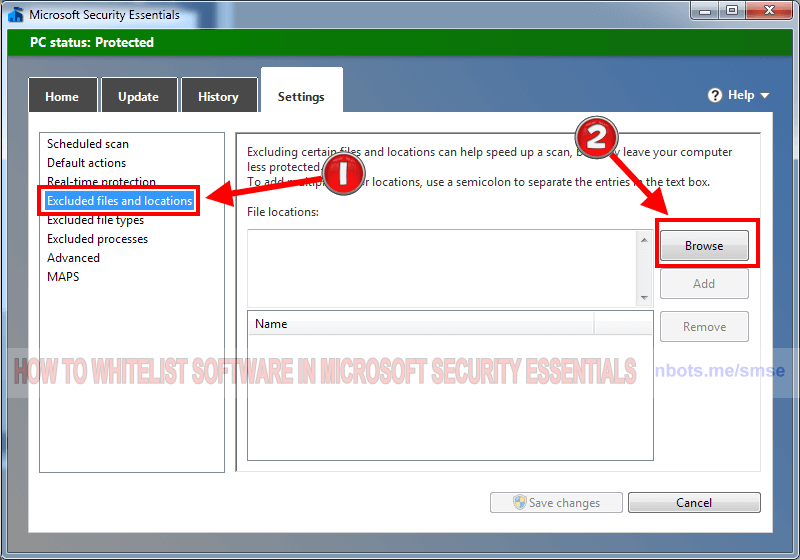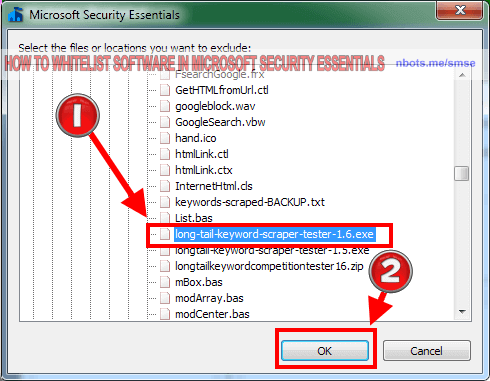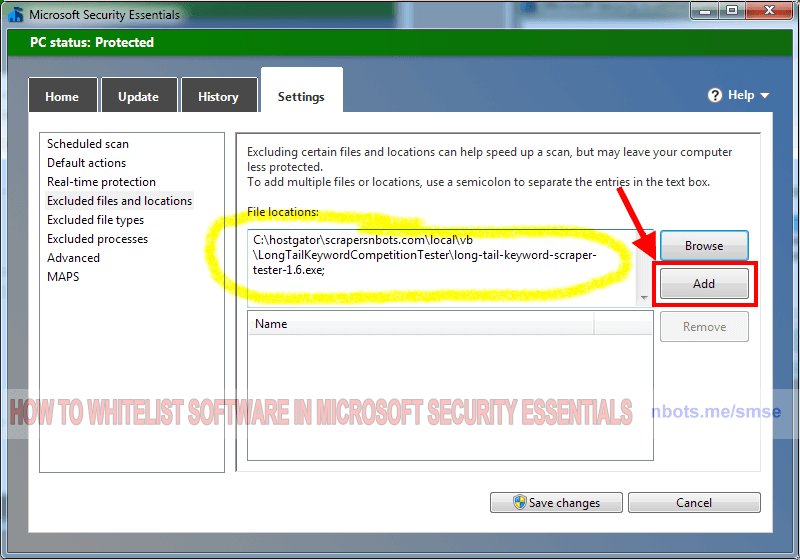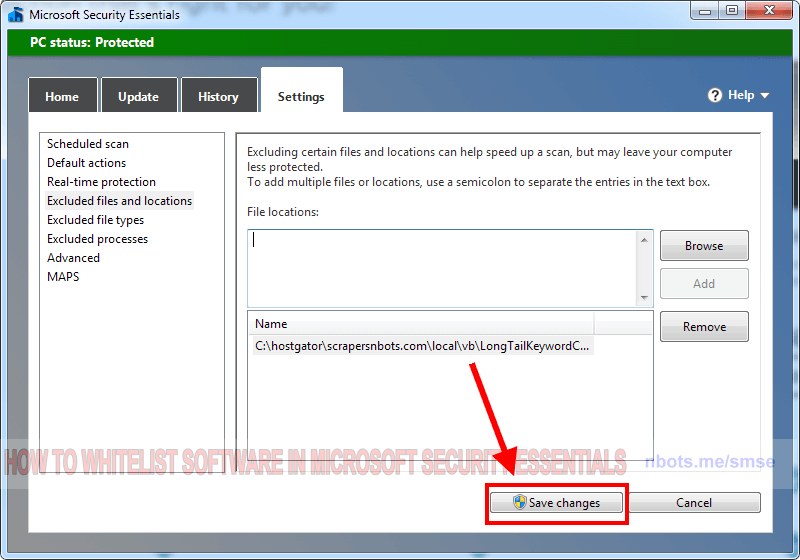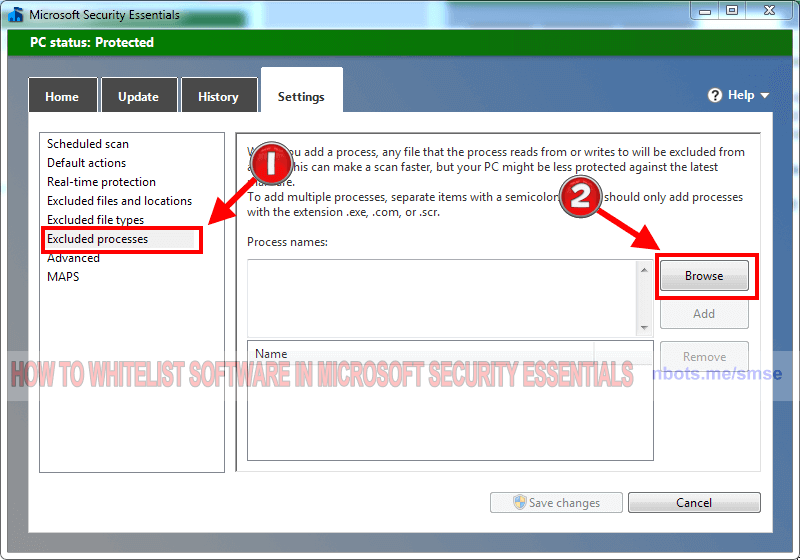Correcting MICROSOFT SECURITY ESSENTIALS Antivirus False Virus Alerts
If you know that a software program is safe, this page contains instructions on how to create program exceptions in MICROSOFT SECURITY ESSENTIALS anti virus.
How to Create File & Program Exceptions in MICROSOFT SECURITY ESSENTIALS Anti Virus Security Program
Microsoft Security Essentials antivirus allows you to whitelist or exclude a file or program BOTH from hard disk AND while running in memory.
To set an exclusion or whitelist a file or program from being scanned and deleted on the hard disk with Microsoft Security Essentials:
- Double click the system tray icon for Microsoft Security Essentials to make the anti-virus program visible.
- Click on the
Settings tab.
- Click on the list item
Excluded files and locations at the left.
- Click the
Browse button on the right. This will open a find-file dialog box.
- Navigate to the location of the program or file you wish to whitelist/safelist in Microsoft Security Essentials and click on it to select it.
- Click the
OK button.
- The find-file dialog box will close taking you back to the settings page. You will see the full path of the file/program you just selected in the
File locations: box.
- Click the
Add button to add the file/program to Microsoft Security Essentials exclusion list.
To set an exclusion or whitelist a file or program from being scanned and blocked from running in memory in Microsoft Security Essentials:
- If you have followed the steps above, you should still be on the
Settings page. Otherwise, follow steps #1 & #2 above.
- Click on the list item
Excluded processes at the left.
- Click the
Browse button on the right. This will open a find-file dialog box.
- Navigate to the location of the program or file you wish to whitelist/safelist in processes in Microsoft Security Essentials and click on it to select it.
- Click the
OK button.
- The find-file dialog box will close taking you back to the Settings page. You will see the full path of the file/program you just selected in the
File locations:
- Click the
Add button to add the file/program to Microsoft Security Essentials running processes exclusion list.
1 Microsoft Security Essentials Antivirus Start Screen.
![Image of 1 Microsoft Security Essentials Antivirus Start Screen. Image of 1 Microsoft Security Essentials Antivirus Start Screen.]()
1 Microsoft Security Essentials Antivirus Start Screen.
2 Microsoft Security Essentials Antivirus Settings Browse For Exclusions.
![Image of 2 Microsoft Security Essentials Antivirus Settings Browse For Exclusions. Image of 2 Microsoft Security Essentials Antivirus Settings Browse For Exclusions.]()
2 Microsoft Security Essentials Antivirus Settings Browse For Exclusions.
3 Microsoft Security Essentials Antivirus Settings File Browse Dialog.
![Image of 3 Microsoft Security Essentials Antivirus Settings File Browse Dialog. Image of 3 Microsoft Security Essentials Antivirus Settings File Browse Dialog.]()
3 Microsoft Security Essentials Antivirus Settings File Browse Dialog.
4 Microsoft Security Essentials Antivirus Add File Program Exclusion To List.
![Image of 4 Microsoft Security Essentials Antivirus Add File Program Exclusion To List. Image of 4 Microsoft Security Essentials Antivirus Add File Program Exclusion To List.]()
4 Microsoft Security Essentials Antivirus Add File Program Exclusion To List.
5 Microsoft Security Essentials Antivirus Save Changes.
![Image of 5 Microsoft Security Essentials Antivirus Save Changes. Image of 5 Microsoft Security Essentials Antivirus Save Changes.]()
5 Microsoft Security Essentials Antivirus Save Changes.
6 Microsoft Security Essentials Antivirus Settings Excluded Processes.
![Image of 6 Microsoft Security Essentials Antivirus Settings Excluded Processes. Image of 6 Microsoft Security Essentials Antivirus Settings Excluded Processes.]()
6 Microsoft Security Essentials Antivirus Settings Excluded Processes.
3 Microsoft Security Essentials Antivirus Settings File Browse Dialog.
![Image of 3 Microsoft Security Essentials Antivirus Settings File Browse Dialog. Image of 3 Microsoft Security Essentials Antivirus Settings File Browse Dialog.]()
3 Microsoft Security Essentials Antivirus Settings File Browse Dialog.
4 Microsoft Security Essentials Antivirus Add File Program Exclusion To List.
![Image of 4 Microsoft Security Essentials Antivirus Add File Program Exclusion To List. Image of 4 Microsoft Security Essentials Antivirus Add File Program Exclusion To List.]()
4 Microsoft Security Essentials Antivirus Add File Program Exclusion To List.
5 Microsoft Security Essentials Antivirus Save Changes.
![Image of 5 Microsoft Security Essentials Antivirus Save Changes. Image of 5 Microsoft Security Essentials Antivirus Save Changes.]()
5 Microsoft Security Essentials Antivirus Save Changes.

